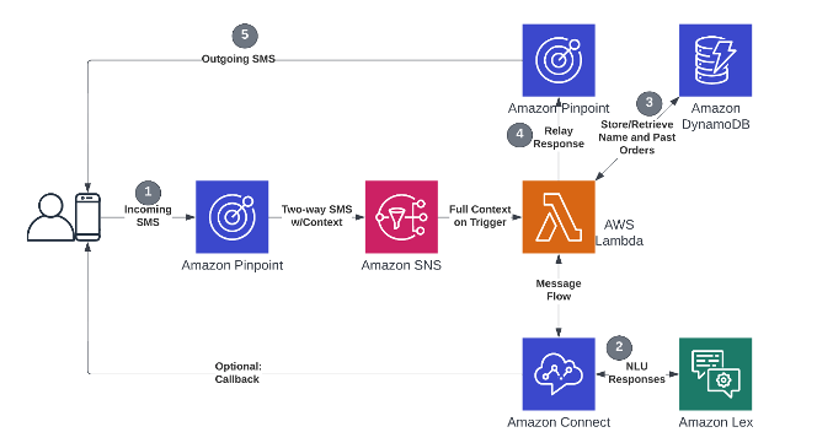AWS for Industries
How Restaurants Can Win Over Generation Z With Text To Order
Introduction
Generation Z (Gen Z), the generation born between 1997 to 2012, includes 67 million individuals, or roughly 20 percent of the US population. Gen Z individuals spend more time texting, also known as short messaging service (SMS), on their mobile devices than any other demographic. The pandemic has galvanized most restaurants to add food ordering or delivery capabilities to their mobile apps. However, most don’t allow orders via text.
Restaurants can benefit from text-to-order capabilities powered by machine learning (ML) and natural language processing (NLP) capabilities. Included in this blog is a high-level architecture with a total cost of ownership estimate and a demo recording of the text-to-order capability developed by Amazon Web Services (AWS) Partner VoiceFoundry.
Restaurant and third-party mobile app challenges
Imagine a fictitious person, Kendra Brady, who is 18 years old and, like most of the Gen Z population, uses SMS for 2–4 hours per day, communicating with friends and family.
Considering such high usage of SMS, it’s unnatural for Kendra to order food by calling a restaurant. Though using a restaurant’s mobile app is not difficult, Kendra finds that often after a few weeks, the app asks for an update and login, thus delaying ordering process. She finds this annoying.
Many mobile apps don’t allow her to use Amazon, Apple, or Google Pay, and she feels uncomfortable, from a security standpoint, providing credit card numbers in different mobile apps for various restaurants.
In addition, many restaurant apps do not offer the flexibility to change the order pickup time, and even if they do, changing the time takes many steps, such as opening an app, providing credentials, finding the last order, and then modifying the order. It’s just not intuitive for digitally savvy diners.
And lastly, many restaurants rely on third-party apps for food orders. However, those apps do not reflect all the menu items that the restaurant offers for direct orders, and some don’t allow for menu item customization. Such an experience is suboptimal for Gen Z users as well as for the restaurant business.
A simpler, faster, and more secure customer experience with text to order
Our Gen Z persona user, Kendra, is looking to order food from Baggiano’s restaurant.
Kendra searches for Baggiano’s in her neighborhood and finds the phone number. Kendra then texts to the phone number. The restaurant’s chatbot, powered by ML NLP, responds and communicates with Kendra.

Note how the restaurant’s chatbot understands and communicates in natural language style as if a restaurant employee is texting. The restaurant’s chatbot accomplishes such natural language communication by using conversational artificial intelligence (AI) from the AWS service Amazon Lex, a fully managed AI service with advanced natural language models.
Also note how the restaurant system is recommending other food items, like fudge brownies, that go well with the main order (#5 menu item and avocado). The system accomplishes this by using Amazon Personalize, a fully managed service that helps companies deliver personalized experiences and recommendations based on ML and deep-learning techniques used by Amazon.com.
Let’s see how simple and intuitive it could be to modify the pickup time, just like when Kendra texts her friends and family when she knows she will be late for an event:

Kendra likes the fact that the restaurant treats her like a real person by remembering her name and the order as soon as she reaches out to the restaurant.
If Kendra decides to order food from the same restaurant again, or even a different franchise location of the same chain, the restaurant remembers her name and past orders, delivering a great experience as shown below.
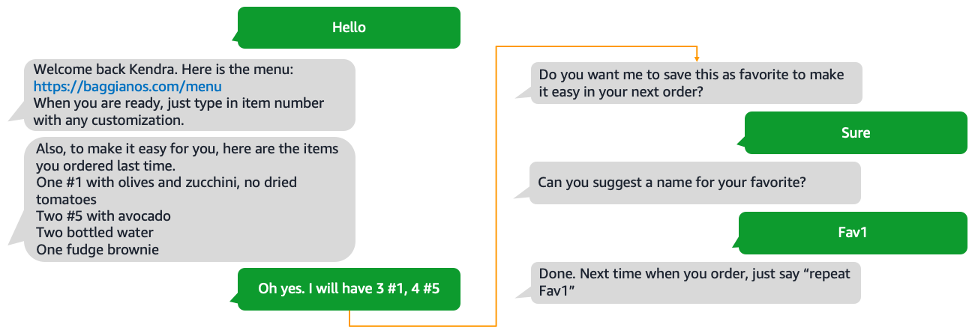
There might be situations when the application will not be able to comprehend Kendra’s intent but would still be able to guide her as shown in the happy-path picture below. But sometimes the application might not be able to comprehend the text messages (exception path below); in which case, it’s best to guide Kendra to make a phone call and, as an option, offer a discount for the inconvenience.
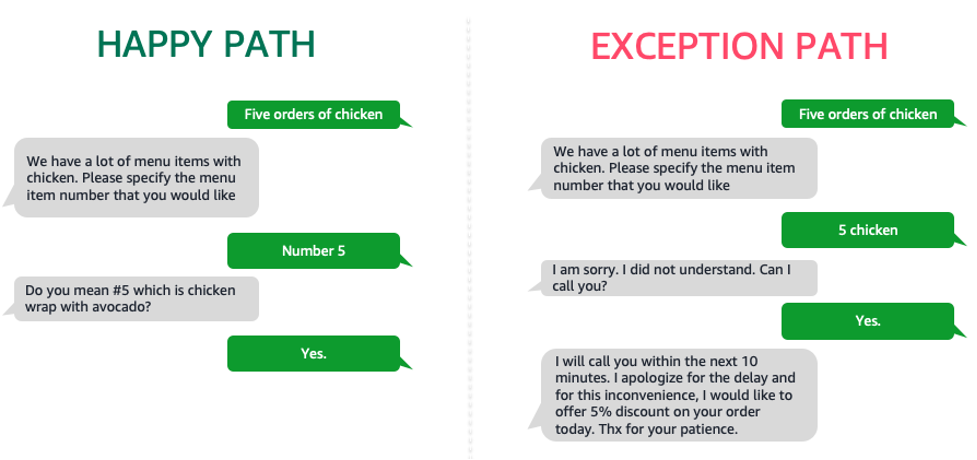
In the rare event that a guest has to switch to a phone call, it’s important that the application remembers the context, current order so far, and past history so that the guest doesn’t have to answer redundant questions from the agent. Amazon Connect, a low-cost, easy-to-use omnichannel cloud contact center, helps deliver such customer experience.
Some guests might still prefer to order food using a mobile app or a phone call. This concept is about creating true omnichannel service and meeting guests in their preferred service channel. Done right, restaurants can attract net new Gen Z guests and other digitally savvy guests with this simple and intuitive experience.
First-party data with text to order
When guests order food directly from restaurants, the restaurants get to know their guests more personally in terms of their names, phone numbers, emails, and preferences. It opens opportunities for restaurants to personalize their communication, offers, and discounts, driving more visits, spending, and loyalty.
Text-to-order architecture and AWS services
A high-level architecture is shown below. For brevity, only the most important services are displayed. For technical implementation details on chatbot construction, refer to the blog: Create an SMS Chatbot with Amazon Pinpoint and Lex.
- Amazon Pinpoint, a flexible and scalable outbound and inbound marketing communications service, receives the SMS message from guests’ mobile phones. Hundreds of thousands of AWS customers have used Amazon Pinpoint to connect with guests over channels like email, SMS, push, voice, or in-app messaging.
- Amazon Pinpoint passes the incoming guest SMS message to Amazon Connect, an omnichannel cloud contact center, by initiating a function of AWS Lambda, a serverless, event-driven compute service. Amazon Connect then communicates with Amazon Lex.
- AWS Lambda lets you run code without provisioning or managing servers.
- Amazon Lex uses AI with advanced natural language models that you can use to build chatbots and voice bots.
- Amazon Lex has the intelligence to understand the intent from the incoming text message, respond back with more clarification questions—such as “5 chicken wraps or Menu item #5 chicken wrap?”—and fulfill the chat request.
- Amazon Lex can use another AWS Lambda function to query and store guest profiles, order history info, and favorite orders in Amazon DynamoDB, a fully managed, serverless, key-value NoSQL database designed to run high-performance applications at virtually any scale.
- Amazon Lex responds back to Amazon Pinpoint using an AWS Lambda function.
- Amazon Pinpoint sends the outbound SMS to the guest.
Demonstrating the ease and value of the proposed solution, AWS Partner VoiceFoundry has created a short 2-minute video of text to order here.
Text-to-order total costs and ROI
*The costs do not include taxes, vary by AWS Region, and were estimated as of March 23, 2022. Please check here for the latest pricing.
Assume the text-to-order capabilities attract 100 orders per month, per restaurant in the first year, with each order generating 10 inbound and 10 outbound SMS texts. Also assume that the restaurant would like to store 10 orders per guest in a database to display historical transactions to the guest.
Table 1 reveals the estimated costs of AWS services and the total cost per order:
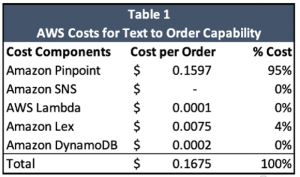
The total cost of the text-to-order capabilities for restaurants is approximately $0.17 per order.
Assume that the average restaurant revenue is $10 per order. Thus, the cost of AWS services to facilitate text to order is 1.68 percent. The graph below shows how the percentage of AWS costs go down as the order size increases.
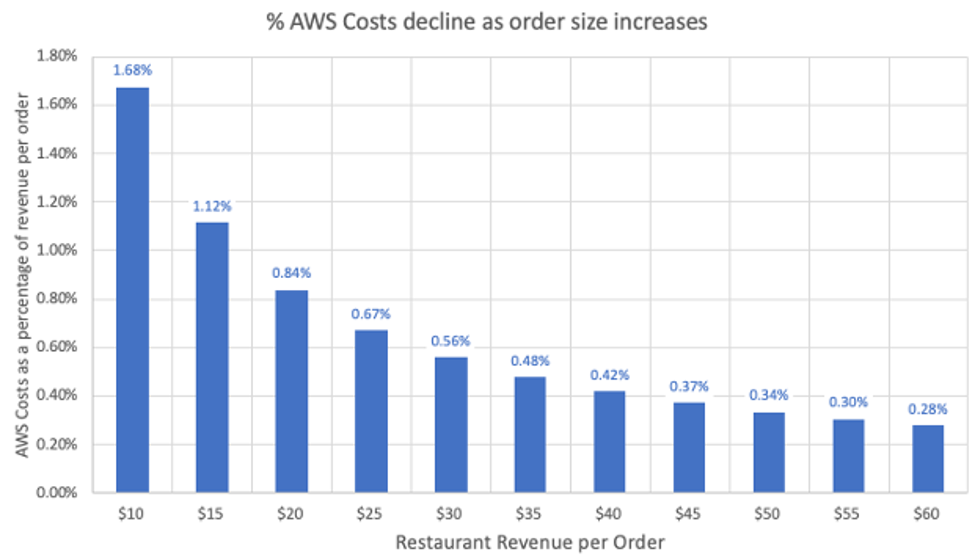
Conclusion
SMS chatbots with text-to-order capabilities deliver value for restaurants and their guests. The simple and familiar SMS-based communication style, along with AI- and ML-driven natural language conversations, attracts net new digitally savvy guests, like Gen Z, and grows top-line revenue for restaurants.
Though this blog uses restaurants as an example, other travel and hospitality industries—such as airlines, ground transportation, and hotels—would also benefit from text-to-order capabilities to book air travel, car rentals, and hotel accommodations or modify existing reservations.
To learn more about how to build text-to-order capabilities, reach out to your AWS account team and/or AWS Partner VoiceFoundry.
